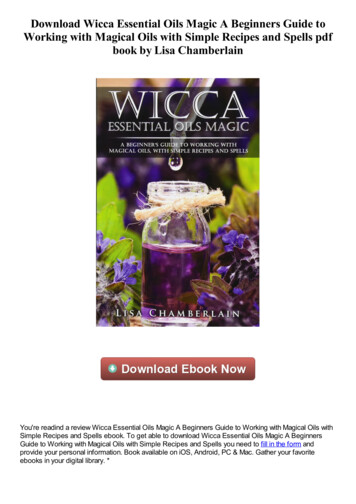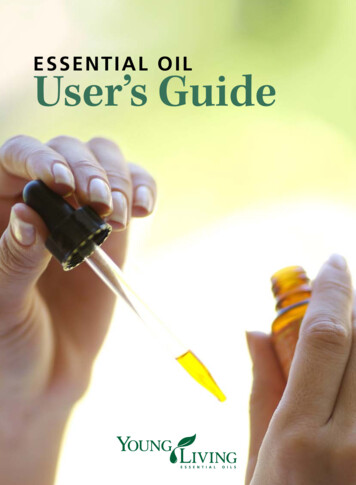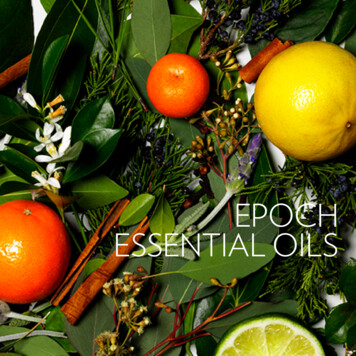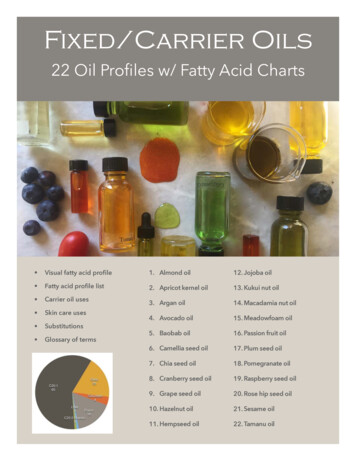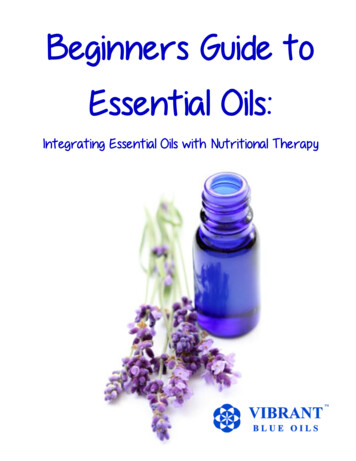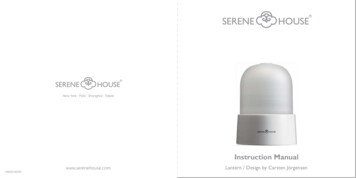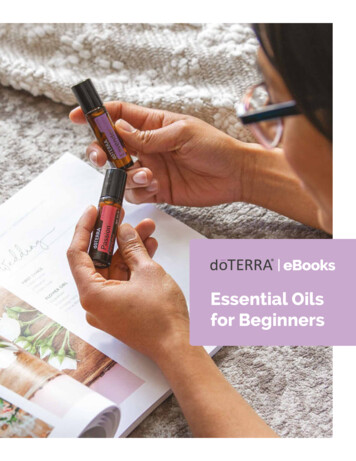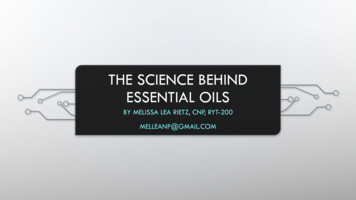
Transcription
Topical Useof Essential Oils
Topical Use of Essential OilsIntroductionThe Body’sLargest OrganDid you know your skin is your body’slargest organ? Just like the liver andkidneys, your skin has vital functionsthat keep you healthy.One of the skin’s most important functions is itprotects your tissues and other organs. It keeps outunwanted or harmful substances and even protects theinternal organs from threats like radiation or injuries.The skin also gives you a sense of touch. It helps youunderstand your surroundings by sending sensorymessages to the brain, recognizing changes intemperature, pain, pressure, and more. When you feelthe soft threads on your favorite blanket, the pricklythorns on a rose bush, or even the wind on your face,that’s all thanks to the receptors on your skin that arecommunicating with your brain.Because the skin plays such a large role in youroverall well-being, it should be protected at all costs.Nourishing and protecting the skin is about more thanjust self-image. When you apply products topically,they absorb into the skin. This is why your choice oftopical products is so important. What you put on yourbody could potentially end up in your body.Whether you care about maintaining a youthfulcomplexion, soothing muscles, or just prioritizingoverall health, taking a closer look at the products youuse topically is a great starting place.For millions of people worldwide, essential oils offera safe, natural way to care for the body. One of theeasiest ways to reap their benefits is through topicaluse. Your skin is powerful. When you use equallypowerful and natural topical products, endlessbenefits await you.In this eBook, you’ll learn all about the topical use ofessential oils and discover their benefits for the skinand body. You’ll come to understand more aboutsensitivity, dosage, and dilution.For millions of peopleworldwide, essential oilsoffer a safe, natural wayto care for the body2
Topical Use of Essential OilsChapter oneWhy Use EssentialOils Topically?In the world of essential oils,topical use refers to the directapplication of an essential oil tothe skin or body. But why useessential oils topically?While aromatic use allows you to enjoyessential oils through the air and internal useinvolves consuming essential oils, topicaluse is a simple way to experience the powerof essential oils and provide significantbenefits for the skin and body. When appliedcorrectly, essential oils can be extremelybeneficial for the skin, soothing for the body,effective for massage, and enjoyed in avariety of everyday ways.Topical use is unique becauseit allows you to target specificareas to achieve a desiredeffect. Along with targetedbenefits, topical application alsoprovides overall support. Onceyou see how easy and effectivetopical application is, you caninstantly enhance your essentialoil experience.3
Topical Use of Essential OilsHistorical Cases of Topical UseUsing essential oils and natural plant components topically isn’t a new trend. It’s a practice that’salready been done for centuries. Ancient cultures throughout the world saw the value of using plants,plant extracts, and essential oils to soothe the skin and body, produce cooling and warming effects,beautify the skin, and much more.Ancient Egyptians usedfrankincense for perfumesand salves to soothe the skin.Australian aborigines usedthe leaves of the melaleucatree for centuries. They’d crushthe leaves and apply them tothe skin for a cooling effect.People of ancient Romefrequently used lavenderfor its relaxing aroma, forbathing, and as a perfume.In Biblical times, cassiawas used on the skin as awarming oil.During the Middle Ages,clary sage was often usedto soothe the skin.The practice of harnessing plants for topical benefits is still in use today.With pure essential oils, you can discover dozens of benefits for thebody—just as civilizations have done for centuries.4
Topical Use of Essential OilsBenefits of Essential Oilsfor SkinBenefits of Topical Usefor the Entire BodyBecause they offer powerful cleansing and purifyingproperties, essential oils have long been used tosoothe, maintain, and improve the skin. Essential oilsare effective for reducing the appearance of skinimperfections, soothing irritated skin, cleansing oilyskin, reducing wrinkles and fine lines, promoting ahealthy complexion, reducing the appearance ofblemishes, and a lot more.Along with impressive benefits for the skin, thechemical components in essential oils make themuseful for the entire body. Some essential oils havecalming properties that soothe your skin. Otheressential oils are known for their warming or coolingproperties, which can be helpful for calming the skin.Certain essential oils can even promote feelings ofclear airways when applied to the chest and neckarea, while others are recognized for their ability tocomfort tired muscles and joints.Unlike many skin care products, essential oilsprovide a pure, natural, and safe way to care foryour skin. While the natural chemical componentsfound in essential oils are helpful for the skin, theydon’t include toxins or fillers that are often found incommercial cleansers, toners, and lotions.On top of the safe, pure nature of essential oils, it’salso easy to accommodate sensitive or delicate skinby diluting essential oils before use. Those withparticularly sensitive skin often have a hard timefinding a skin care solution that won’t irritate. Not onlydo essential oils leave out the parabens and toxinsoften found in skin care products on today’s market,but they can also be diluted to accommodate peoplewith particularly sensitive skin. Anyone who worriesabout skin irritations and sensitivity can still reap thecleansing, purifying benefits of essential oils for the skin.As mentioned before, one of the advantages ofusing essential oils topically is your ability to target aspecific area of the body. Topical application allowsfor specific, targeted usage, which means you canselect a specific essential oil based on its knownbenefits, and then apply it to a precise area to achievean effect you want.Now that you understand the vastbenefits of topical use, we’ll diveinto how essential oils deliverbenefits when used topically.5
Topical Use of Essential OilsChapter twoHow ItWorksWe know skin plays avital role in protectingthe body and keeping ithealthy. Understandingwhat an important andpowerful organ theskin is helps us to seehow we can use topicalapplication of essentialoils to influence health.Essential oils are a lipid-solublesubstance, which means theypenetrate the skin easily. Topicalapplication is an effective way to useessential oils because once they’vebeen absorbed into the skin, they’llremain in the applied area, givingyou benefits in a localized area.Each essential oil has a uniquechemical profile that determinesthe benefits it provides. Certainessential oils have topical warmingproperties, while others havechemical components that makethem topically calming, soothing,or cooling. When an essential oil isapplied topically and absorbed intothe skin, you begin to experiencethe benefits of a specific essentialoil’s chemical properties.6
Topical Use of Essential OilsFor example, let’s say you apply Tea Tree toyour skin. The unique chemical profile of TeaTree essential oil includes components thatare known to be cleansing. This means whenyou apply Tea Tree topically, those chemicalcomponents go to work, allowing you toexperience the skin-cleansing benefits ofthe essential oil.Or say you put Sandalwood on your skin.Sandalwood includes chemical componentsknown for being soothing. So after applyingSandalwood to the skin, you’ll experience theessential oil’s soothing benefits, including itsability to soothe occasional blemishes or skinirritations.Not only does topical use allow you to reap thebenefits of essential oils for the skin and body,but you simultaneously get to enjoy the aromaticbenefits of any essential oil being applied. Yousee, after applying an essential oil topically, itsaroma will linger on the skin, and you can breathein that aroma for up to a few hours. Even if you’reusing an essential oil for its topical benefits, you’llalso experience a unique aroma as it sits on yourskin and you breathe it in.With a better understanding of how topical use ofessential oils can impact the body, you’re readyto learn about proper safety practices to help youmaximize your essential oil experience.7
Topical Use of Essential OilsChapter threeSafetyUnderstanding safety precautionsis necessary with any topicalproduct you plan to put on yourskin. You’d never go to yourbathroom cabinet, grab a randombottle, and start washing yourselfwith it—you’d read the labeland instructions first. The samegoes for essential oils. Pure,unadulterated oils are safe toapply to your skin, but just likeany product, there are importantrules and safety precautions tobe aware of. With a better graspof safe topical use, your essentialoil experience will be botheffective and enjoyable.DilutionCarrier OilsWhen it comes to safe topical use of essential oils,dilution is one of the most important principles tounderstand. Some worry that diluting an essential oilbefore applying takes away from its benefits; however,dilution actually makes for better absorption into theskin, extending the benefits even longer. By dilutingan essential oil with a carrier oil, you slow the rate ofevaporation, enhance absorption into the skin, andprotect sensitive or delicate skin. Dilution doesn’t takeaway from the essential oil experience, but rather allowsfor more effective topical experience.A carrier oil is just what it sounds like—an oil thatliterally carries essential oils to the desired areaon the skin. Carrier oils are incredibly useful fordilution. When you dilute an essential oil with acarrier oil, it dilutes the potency of the oil; however,it also increases absorption into the skin, whichultimately allows you to maximize the benefits theessential oil has to offer.8
Topical Use of Essential OilsIdeally, a carrier oil should be a pure vegetableoil so it can easily dilute an essential oil withoutdamaging its delicate chemical profile. If anessential oil’s chemical makeup is altered ordamaged in any way, its efficacy is reduced, andyou won’t reap the desired benefits.The following carrier oils are commonlyused to dilute essential oils: Coconut oil Avocado oil Walnut oil Macadamia nut oil Sweet almond oil Linseed oil Sunflower oil Olive oilIn most cases, carrier oils contain chemicalcomponents that oxidize over time. As you shopfor carrier oils, you may find some have beenfractionated, or gone through the process offractionation. During the process of fractionation,the shorter length fatty acid chains are separatedout to give the oil a longer shelf life.dōTERRA offers Fractionated Coconut Oil, whichis an example of a carrier oil with a long shelf life.Because it’s derived from coconut, it has a nongreasy, lightweight feel when used as a carrier oilon the skin.Dilution GuidelinesdōTERRA provides skin sensitivity descriptors oneach essential oil to help users avoid sensitivityissues by practicing safe use. Each productincludes one of three classification labels: “N” forneat, “D” for dilute, or “S” for sensitive. These labelscan help you determine how to safely apply anessential oil topically.Neat: Essential oils in this classificationcan be applied without dilution. Theseessential oils tend to have a mild chemistryand low risk when it comes to sensitivity.Dilute: This category refers to essential oilsthat should always be diluted with a carrieroil before topical application. These essentialoils have a stronger, more potent chemistrythat can be safely enjoyed after dilution.Sensitive: These essential oils shouldalways be diluted before using on youngor sensitive skin. Pay attention to this labelif you have sensitive skin or if you plan touse essential oils with your children.9
Topical Use of Essential OilsApplication TipsDosageWhile essential oils vary in chemical components,potency, and aroma, there are some areas of the skinthat are extremely sensitive and should always beavoided, no matter what kind of essential oil you’reusing. The eyes and the skin around the eyes, theinner ears, and injured, broken, or damaged skinshould always be avoided.One key part of using essential oils safely is observingproper dosage suggestions. Whether you’re usingan essential oil aromatically, topically, or internally,ensuring you use the correct amount will allow you toremain within the limits of safe usage.It’s important to remember that essential oils can lingeron the fingers and hands following topical application.After topically applying, avoid rubbing or touchingyour face and eyes, as these areas can be sensitiveto essential oils. You might also wash your hands withsoap and water after applying essential oils topically tohelp avoid contact with sensitive areas.With topical use, there’s always a risk for skin irritationor sensitivity, especially when you consider thateach essential oil has a different chemical profile andeach person has different skin sensitivity levels, skinconditions, and preferences. Remember, an essentialoil dose depends on your age, size, health status, andpersonal skin sensitivity. If you have specific concernsabout your skin, it’s a good idea to consult with yourphysician before using essential oils topically.When using an essential oil topically for the first time,always start with the lowest possible dose: one to twodrops. Once you see how your body reacts to the smalldose, you can increase it as necessary to achieve a desiredbenefit. Because essential oils are so potent, it’s advisedto use a few small doses periodically throughout the day,rather than a single large dose all at once. For topical use,a dose can be repeated every four to six hours. Start withRepeat everyone to twodropsand increase as necessary.four to sixhoursas needed.10
Topical Use of Essential OilsSensitivity TestBecause each of us has different sensitivities, healthconcerns, skin conditions, and preferences, it’spossible for an essential oil to cause a sensitivityresponse. Children or those with sensitive skin shouldtake extra safety precautions when using essential oilstopically.When applying an essential oil for the first time,consider conducting a sensitivity test to see how yourbody and skin react to its chemical structure. You cando this by applying a small dab of the essential oilto an inconspicuous area of the skin. Check the areaeach hour for a few hours to make sure no sensitivityor irritation has occurred. If you’re using a strongessential oil for a sensitivity test, be sure to combine itwith a carrier oil before topical application.Sun SensitivityIt’s important that you know some essential oils,particularly citrus oils, can cause sensitivity whenexposed to sun or ultraviolet light after topicalapplication. Because citrus oils have photosensitivecompounds, exposure to sunlight, UV light, orsunlamps at least 12 hours after application can causesensitivity on the skin. Essential oils that pose a risk forsun sensitivity typically include a warning or caution,so carefully read essential oil labels before usingtopically.Many people wonder if essential oils are safe to useon the skin and body. The answer is absolutely! Justlike any other product on your bedside table or in yourbathroom cabinet, when used as intended, essentialoils are designed to help you, not hurt you. Equippedwith the best safety tips, you’re ready to start usingessential oils topically!In the next chapter, we’ll go over some ideas to helpyou get started.11
Topical Use of Essential OilsChapter fourIdeas for TopicalApplicationNow that you’ve learned aboutdilution, sensitivity, and dosage,it’s time to discuss how to actuallyapply essential oils topically! Theprevious chapter discussed a fewsensitive areas to avoid duringtopical use. Now let’s talk aboutsome of the best areas to applyessential oils so you can reap theirtopical benefits.12
Topical Use of Essential OilsFaceYou can add essential oils to your daily skin careregimen to improve the skin and maintain a clearcomplexion. To incorporate essential oils to yourroutine, simply add a few drops to your facialcleanser, moisturizer, or body lotion. You can alsodilute essential oils with Fractionated Coconut Oiland apply them directly to your face.Some of the best essential oils here include TeaTree, Sandalwood, Lavender, Helichrysum,Jasmine, and Frankincense.Temples, forehead, baseof the skull, and neckApplying essential oils to any of these areaswill allow you to enjoy their soothing effectson the skin. If you tend to hold a lot of tensionin your neck, work long days behind a desk,or just need to unwind after a tense day,consider massaging soothing and relaxingessential oils to any of these areas.AbdomenWhile using essential oils internally can helprelieve digestive discomfort* or promote healthydigestive function,* you can also apply themtopically to the abdomen to experience soothingproperties. Massage essential oils into theabdomen and enjoy their aromas.Consider applying DigestZen Digestive Blend orDigestZen Touch for this.*These statements have not been evaluated by the Food and DrugAdministration. This product is not intended to diagnose, treat, cure, orprevent any disease.13
Topical Use of Essential OilsArms, legs, and backMassaging essential oils onto the arms, wrists, legs,and back after a workout or any sort of strenuousphysical activity allows you to harness their soothingpowers. Many essential oils have cooling and warmingproperties, which make for a relaxing massage afterexerting yourself.Cypress, Frankincense, Wintergreen, and Peppermintare especially helpful when it comes to topical relaxingcomfort. You can also try using Deep Blue Soothing Blendto help your arms, legs, or back when you need it most.ChestThe cooling and invigorating properties of essentialoils can promote feelings of clear breathing whenapplied topically to the chest. Plus, this type of topicalapplication allows you to simultaneously enjoy thearomatic benefits of the essential oils as you breathe in.The best essential oils for topical application onthe chest—known for promoting feelings of clearbreathing—include Peppermint, Eucalyptus, anddōTERRA Breathe Respiratory Blend.Bottoms of the feetThe bottoms of the feet are an ideal place to applybecause the feet readily absorb the essential oils.When trying an essential oil for the first time orwhen using with children, the bottoms of the feetare a good starting place, as the skin is thick andless prone to sensitivity.14
Topical Use of Essential OilsIf you want to make topical usagea part of your daily routine, hereare some more ideas to help youexperience the everyday power ofessential oils. As always, rememberto pay attention to any precautions orspecific instructions before applying,including the classification of eachoil: neat, dilute, or sensitive.Using Essential Oils in a Massageto Soothe the MusclesNext, let’s go over ways to use essential oils to soothe themuscles. Essential oils with soothing, warming, or coolingproperties (or any combination of such properties) areeffective for massaging the muscles, especially after physicalactivity, a long day on your feet, or when you need extracomfort. When you massage pure and potent essential oilsinto targeted areas, your body will feel the natural, powerfulcomfort they have to offer.Here are a few essential oils and methods you can use tosoothe your muscles:Using Essential Oilsfor Personal Care Throughout this eBook, we’ve talked extensively about the the neck as part of a relaxing massage. care routines to improve the look or feel of their skin.Cinnamon Bark can be diluted and applied to helpsoothe your joints.into your personal care routine: benefits. Add Frankincense to your daily moisturizer to reducethe appearance of skin imperfections and rejuvenateMassage Deep Blue or Deep Blue Rub into the kneesand feet after exercising.Apply Bergamot to the skin while showering toexperience a calming aroma and skin-purifyingAdd essential oils like Clove, Cassia, or Ginger to alotion and apply to the muscles for a warming massage.Here are just a few ways you can incorporate essential oils Massage Wintergreen into the hands, back, and legs fora warming and soothing sensation after exercise.benefits essential oils hold for the skin. This is why millions ofpeople worldwide choose to use essential oils in their personalApply dōTERRA Balance to the temples and back of After a day of outdoor activity, apply Frankincense tothe hands and feet for a warming and soothing effect. Prior to a long run, use Cypress on the feet and legs.the skin. After too much time in the sun, add Lavender tounscented lotion and apply it to the skin for soothingcomfort. Apply Helichrysum to the face to reduce theappearance of wrinkles and promote a glowing,youthful complexion. Add Grapefruit to your nightly facial routine. (Makesure to avoid sun exposure and UV lights for at least 12hours after application.) Rub Tea Tree on your fingernails and toenails after ashower to keep them looking clean and healthy. Apply Lavender or Sandalwood to the skin after shavingto help prevent skin irritation.15
Topical Use of Essential OilsConclusionOne Drop AwayNow that we’ve discussed some ofthe ways topical use can changedaily life, it’s easier to see why somany people rely on these gifts ofthe earth.Whether you want glowing skin, soothed muscles afterexercise, or natural alternatives to commercial productsyou’re used to, topical use of essential oils can be apowerful avenue for changing the way you feel every day.With accurate knowledge of the best ways to applyessential oils and how to use them safely, you’re just onedrop away from changing your day. The next time youcould use soothing comfort or serious support, reach fora bottle and see how quickly things can change for thebetter.Want to learn more? Continue your essential oil journeyby visiting doterra.com today!16
found in essential oils are helpful for the skin, they don’t include toxins or fillers that are often found in commercial cleansers, toners, and lotions. On top of the safe, pure nature of essential oi


